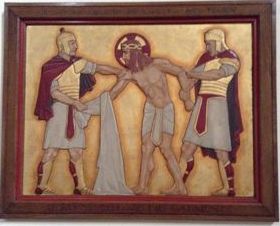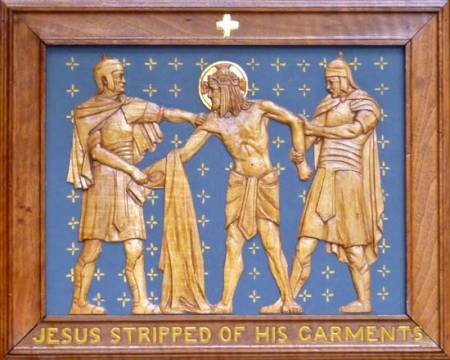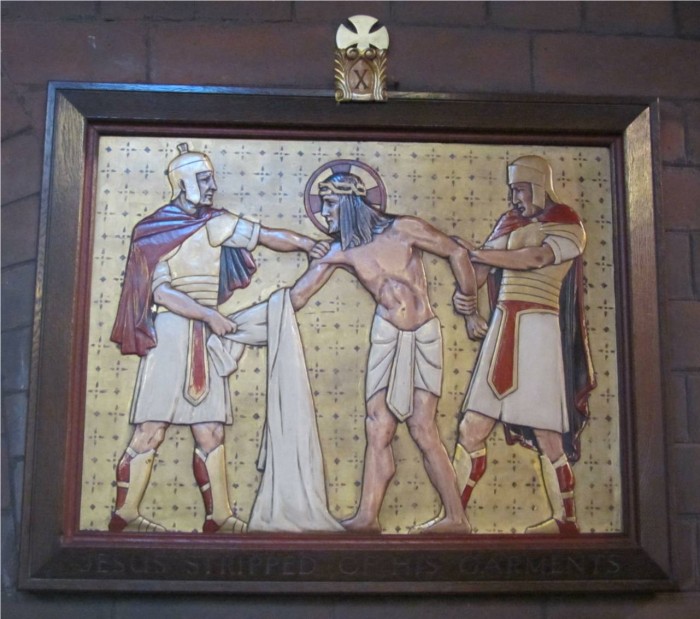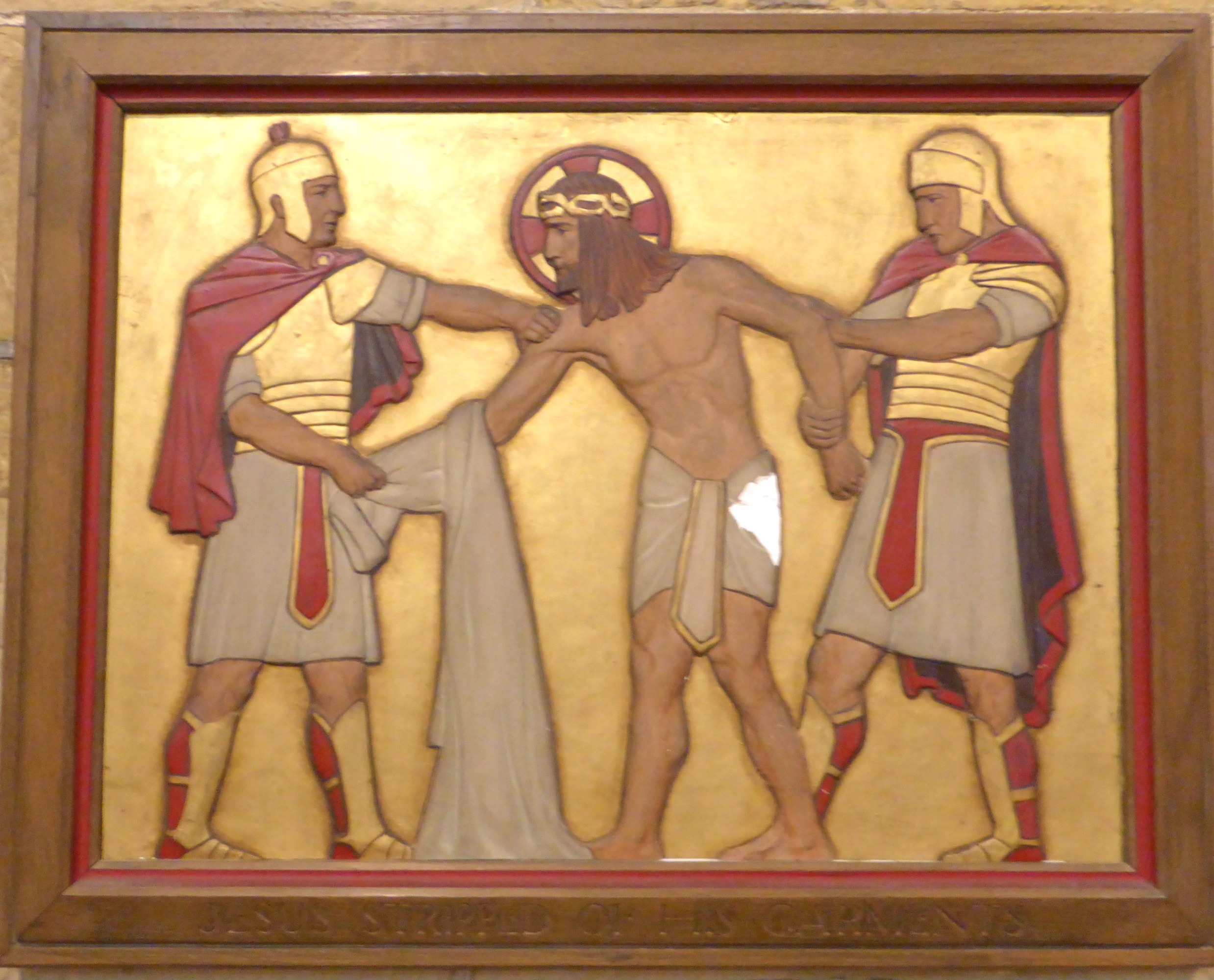The Stations of the Cross in St Michael's Church - A Mystery Solved?
David Duce and Paul Sheppy
19 March 2016
J.C. Norris in his history of St Michael's Church 1867-1967 wrote "A full set of Stations of the Cross hangs on the walls of the nave. Of these, number 9 was a memorial to the late Mr. Perrin, while numbers 13 and 14 were purchased out of moneys subscribed for a memorial to Miss Hearn. These three were hung on 20th January 1945. The remainder were obtained subsequently." Our current "Notes for Visitors" leaflet states "The origin of those [Stations of the Cross] acquired in 1945 and later is unknown, but an identical set has been seen elsewhere". This statement is no longer true and we also now know something of what lies behind the second part.
Images of the stations of the cross
When Fr Oliver Holt OSB, monk of Douai Abbey, visited St Michael's to deliver one of the talks in the Studies in the Psalms course in February 2016 he was impressed by the Stations of the Cross sited around the church. We gave him a copy of our leaflet on the Stations of the Cross and amazingly he has discovered the origin of this set.
The story starts with the Society of Faith [1] founded in 1905 by two brothers, Charles and John Douglas, both priests. In 1935, it took on the lease of Faith House in Westminster, which provided a base for the activities of the Society, in particular a bookshop for the Faith Press and workspaces for Faith Craft. Faith Craft artists and designers produced stained glass, vestments, statues and other carvings, liturgical furniture, sacred vessels and other ornaments.
It turns out that our Stations of the Cross were produced by Faith Craft. A brochure for these Stations can be found on the Faith Craft web site [2]. According to the web site this dates from 1930-35 at the latest. The Stations were designed by Ian Howgate and the wooden originals carved by William Wheeler. Plaster casts were made from these originals and could be purchased for £4-10-0 each (roughly £160 at 2016 prices). The brochure notes that Stations could be purchased as a set or individually and that inscriptions could be added at "a small extra expense". Our Stations are instantly recognisable from the pictures in the brochure.
A quick web search has since revealed that a church in Harrow recently (2012) acquired a wooden carved set of Stations of the Cross by forgotten St Alban's artist, Ian Howgate. This set was found in a sorry state in a shop in Walsingham and has been painstakingly restored by a fine art restorer. An article in the Herts Advertiser [3] (dated 29 November 2012 in the on-line version) has some details: "Ian Howgate, an ecclesiastical artist, attended the St Albans School of Art in Victoria Street. In the 1930s he worked for Faith-Craft in St Albans, a high quality ecclesiastical stained glass and furnishing enterprise owned by the Anglo-Catholic society of the faith. He served in the RAF during the Second World War, but did not return to a career in art afterwards. Ian, who died in St Albans in 1989, worked for Marconi." Interestingly the article also adds "Ian's painting of the coronation of the Blessed Virgin Mary is on the ceiling of the apse of the Anglican Shrine of Our Lady of Walsingham, which he completed in 1938".
There are photographs of these Stations of the Cross on the web site [4] of St George's Headstone, Harrow.
Tenth Station (St Michael's)

Tenth Station (from St George's web site)

Tenth Station (from St Augustine's web site)

Tenth Station (Christ Church, St Leonards' on Sea)

A little more reading of the Society of Faith web site revealed that in January this year they published the proceedings of a symposium on Faith Craft held in 2013 entitled "All Manner of Workmanship" [5]. Their web site also contains a report of the symposium [6].
Quoting from that web page: "The Society of the Faith's symposium on Faith Craft was held in the splendid setting of St George's Church, Headstone, North London, where there are several examples of Faith Craft work visible… Finally, Father Keeble [parish priest at St George's] then discussed the Faith Craft work in St George's, which was all that emanated from a much larger scheme, and discussed the recent finding and restoration of the carved wooden Stations of the Cross by Ian Howgate. As part of his talk Fr Keeble invited Dick Onions (artist) to give his memories of working with William Wheeler, a woodcarver who was Art Director for Faith Craft between 1932 and 1939 and how, after war service, he became an instructor in carving at the City and Guilds of London Art School in Kennington, where Mr Onions knew him."
A further web search, knowing the connection to Faith Craft and Ian Howgate revealed that St Augustine's Church, Tonge Moor, Bolton, also has a set of Stations of the Cross like ours [7].
This web page contains the text "This set of the Stations appears to be a copy of a set designed by Ian Howgate in the mid-1930's, who worked before the Second World War for Faith Craft, the church furnishing branch of the Society of the Faith. That set was of carved wood: it was found languishing in the back of a shop at Walsingham (where else!), was restored, installed in the church of St George, Headstone, Harrow".
They were ahead of us in finding the link to Faith Craft and the wooden set at St George's Headstone.
Fr Stephen Keeble's article in "All Manner of Workmanship" [5] has more details about the discovery and restoration and of the artist Ian Howgate and woodcarver William Woodgate. The wooden carvings are 15 inches by 12 inches in their frames, smaller than the painted plaster set. Their voyage of discovery led them to St Saviour's Hitchin, Christ Church St Leonards-on-Sea and St Chryostom's Manchester. He writes that subsequent investigation has "shown there to be at least twelve of the painted plaster sets, twice the size of he Headstone panels". Their research also led them to material deposited in the Hertfordshire archives by Ian Howgate's widow and to more information about the wood carver, William Wheeler, who was made a Freeman of the Worshipful Company of Carpenters and a Freeman of the City of London in 1951.
As amateur detectives we feel progress has been made on the mystery of the Stations of the Cross as St Michael's approaches its 150th anniversary of the consecration on Friday 25th January 1867.
Like all good mysteries there are undoubtedly more layers to this story. How many sets of the plaster casts were made, exactly how many are still in existence and where? How did St Michael's come to choose this set of Stations of the Cross? Where did the money come from to fund the purchase of the remaining stations? Was there some service of dedication when some/all were in place? How were they used liturgically? If only more archives were available digitally in a searchable format, or indeed, more records had been kept!
Thank you, Fr Oliver, for finding the link to Faith Craft and launching this trail of discovery.
Postscript (David Duce, 20 October 2018)
From a photograph shown in a slide by Carolynn Pritchard during a talk she gave at the Society for Liturgical Study conference in August 2018, it appeared that St Margaret's Church in Ilkley West Yorkshire (dedicated in 1879), might also have the same set of Stations of the Cross. Their web site [8] and a visit to the church confirmed this. From their web site "Round the walls of the aisles a fine set of Stations of the Cross are plaster casts from original wood carvings from the studios of Faith Craft, one of the fine guilds of craftsmen now alas squeezed out of existence.". The church's rood figures were also from Faith Craft Studios. The colour of some of the clothing is bright white which seems to be closer to the colour of the set at St Augustine's. Looking at the tenth station, the St Michael's copy has a plain background, both the St Augustine's and St Margaret's set have a grid of small crosses on the background. Perhaps these differences are a result of the St Michael's set being purchased at different times. Another set has also been seen by the author in Christ Church, St Leonard's on Sea (referenced in [5]). The colours of the St Leonard's-on-Sea set are close to the St Michael's set and it is known from a plaque placed near the first station that they were purchased in 1946.There are differences too in the frames of these sets perhaps local choices or changes over time.
Postscript (David Duce, 6 January 2024)
Our thanks to the web master at Christ Church St Leonard's-on-Sea for providing the picture of the tenth station in their set.
Sources
- http://www.societyofthefaith.org.uk/about-us
- http://www.societyofthefaith.org.uk/wp-content/uploads/2014/08/Stations-of-the-Cross-leaflet.pdf
- https://www.hertsad.co.uk/news/21958905.forgotten-st-albans-artists-stations-cross-unveiled-harrow-church
- http://www.stgeorgeheadstone.org.uk/st-georges-church.html
- All Manner of Workmanship, edited by Robert Gage, Spire Books, 2016, ISBN 978-1-904965-50-3
- https://www.societyofthefaith.org.uk/faith-craft-2/faith-craft-symposium-report
- https://www.staugustinestm.org.uk/photos
- https://www.stmargaretsilkley.org/information/brief-church-history and https://www.stmargaretsilkley.org (a picture of one of the stations appears by rotation in the images at the top of this page) [Accessed 20/10/2018]

